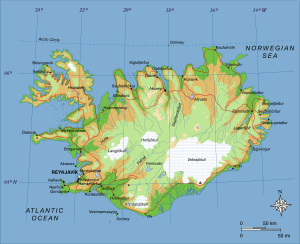Icelandic/Introduction
Icelandic |
Forsíða | Inngangur | Stafróf og framburður | 01 | 02 | 03 | 04 |
| Viðaukar: Stórir Bókstafir | Nafnorð | Sagnorð | Óregluleg sagnorð | Lýsingarorð | Atviksorð | Töluorð | Orðtök | Klukkan | Annað: Verkfæri |
Inngangur
- Introduction
Welcome to the world of Wikibooks' language guide in learning the Icelandic language. You are here either because you have an interest in learning this wonderful ancient and modern language, you are either Icelandic or have Icelandic blood, you have a passion for Scandinavian or Nordic languages, you are connected somehow to Iceland, you want to fully grasp the Icelandic sagas in its original language, you will take a trip to Iceland soon and want to communicate with the locals, or you just want to learn a language for fun. Whatever the reason may be for wanting to learn the language, you are here now and we are here to help you learn the language. Velkomin! (Welcome)

Icelandic is the mother tongue of about 320,000 people in the world. It is the only official language of the Republic of Iceland. The language has existed for a very long time, though called different names (such as Old Norse). Icelandic is one of the most unchanged and purest languages in the world. It is said that a speaker of Icelandic would be able to talk with a Viking hundreds of years ago without much difficulty. A speaker of Icelandic can also read the sagas without much difficulty either.
The Icelandic language belongs to the Western Scandinavian language group along with Faroese, the language of the Faroe Islands. It is possible to see many connections between the other Scandinavian languages too, such as Norwegian, Danish, and Swedish. If you are familiar with any other Scandinavian language, learning Icelandic shouldn't be a problem for you.
The most difficult aspect to grasp in Icelandic would be the complex grammar. There is a case system, like in German and Latin, that might frustrate English speakers or those who are not familiar with grammatical cases. This means that words will change form or have endings depending on what function of the sentence they have. Even names will change. If you have studied Latin before, you might be able to see some similarities between the grammar aspects of the language.
Do not be discouraged by the grammar though, this book is not a book designed to just drill grammar rules into your head. We will start off with the basics so you can communicate effectively in Icelandic, then slowly introduce grammar rules so you will be able to construct sentences of your own.
Remember that all languages are difficult to learn. Do not expect Icelandic to come easy, because nothing in life worth having comes easy. If you start to become frustrated, just think about how well you can speak English or whatever your mother tongue might be. If you can expand your vocabulary in English, then you should have no problem doing it in a foreign language. The feeling of being able to communicate in a foreign language is rewarding, especially that of Icelandic.
Read more about the Icelandic language
How to use this book
editThis book is a free content open source guide in learning the Icelandic language. Though it can be edited by anyone, it is also being monitored by the authors and administrators of this book and Wikibooks, to assure you 100% accuracy. So do not be discouraged about using this book as a primary or secondary reference in your language studies as this book is not giving you any false information.
The book is set up in step-by-step lessons which will introduce the language like a classroom setting and similar to a textbook style tutorial. It will commence with the basics of the language, and gradually introduce grammar aspects of the language, rather than give you a bunch of grammar explanations and a massive list of vocabulary to learn on your own. The book is set up accordingly so you can go at your own pace whether you are a fast learner or prefer to take your time.
Do not skip over the Málfræði (Grammar) sections. Though sometimes it might seem like a lot, it is essential information to read and understand. Icelandic grammar is difficult, but we will try to explain it as easily as possible for a simple understanding.
Use the navigation header above to navigate to the next lesson, a previous lesson, or the pronunciation guide. There will also be appendices (grammar references) at the end of the book which you can navigate to.
At the end of each lesson there will be small exercises to test yourself on the knowledge you've gained and accumulated in the previous lessons. Do not be tempted to skip over them! It is very easy to just say Oh! I have done enough, I know the answers, no problem at all. Try to work on each question and check yourself. This will only improve your knowledge on the language.
Learning a language is a tough challenge, but with this book, we will try to make it as informative, fun, and motivative as possible to help you learn the Icelandic language. A good way to practise is reading the Icelandic wikipedia! Listen to Icelandic radio too at Útvarpsaga.is live. (Click on On air (Hlusta í beinni) in the left corner and it will open in your browser or media player). Útvarp Saga is more or less geared to older people, but it is the radio station that contains the most talk. It might be a great way for a learner to understand conversation in Icelandic.
Gangi þér vel!